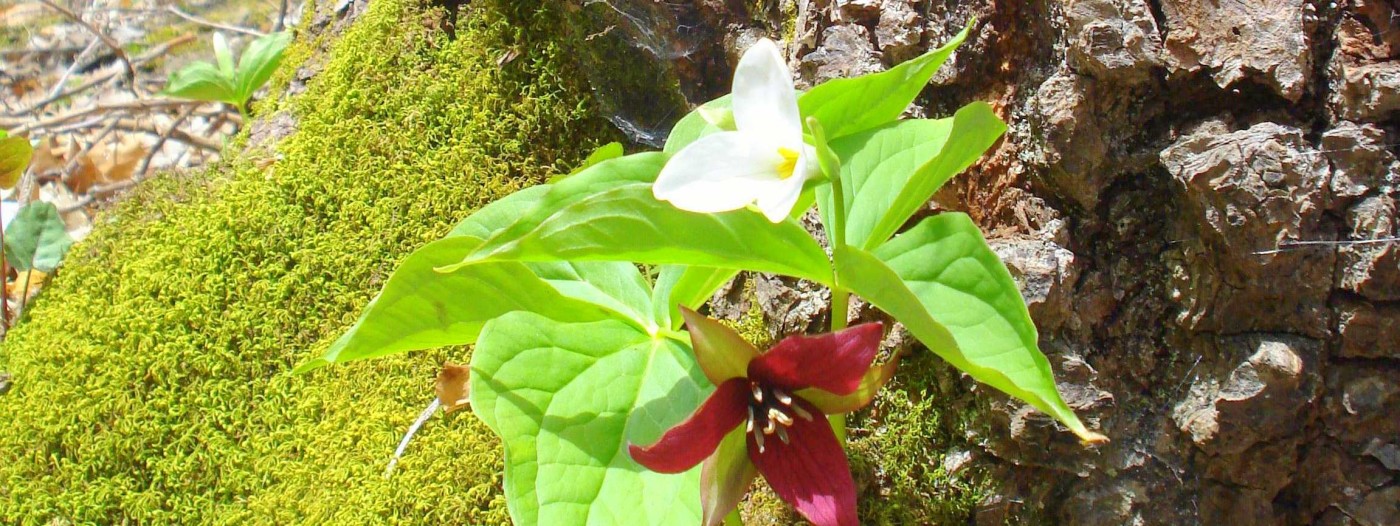Animals and Plants of the Finger Lakes
Spring Wildflowers & Mirmecochory
By a process known as myrmecochory, ants act as the seed-dispersers of a number of our familiar forest spring wildflowers.
White and red trilliums, wild ginger, bloodroot, Dutchman’s breeches, trout lily, trailing arbutus, and various species of hepatica and violet all depend on ant colonies to spread their progeny across the forest floor.
Myrmecochory is a mutualism — that is, a relationship benefiting both participants. The seeds of myrmecochorous plants have an oily, nutritious attachment called an elaisome. Woodland ants take the seeds back to their nests, eat the elaisomes, and discard the seeds underground. The plant receives several benefits in return for the small amount of energy it takes to make this “ant bait.” Its seeds are neatly planted (rather than merely dropped on the ground) in soil that has been enriched by waste from the ant colony; they are protected from such predators as mice; and, since the seeds have been moved some distance away from the parent plant, seedlings are less likely to be in competition with others of its own species.

However, there is no getting around the fact that myrmecochory is a very inefficient way to spread seeds afar. Plants with seeds that are dispersed only in this fashion will typically spread extremely slowly. Ants cannot cross barriers such as roads or streams, they will not cross from one habitat into another, and they rarely move seeds more than a few meters in any case. In theory, it should be impossible for myrmecochorous plants to recolonize abandoned farm fields, because only woodland ants feed on seed elaisomes; farm field ants feed on a substance excreted by aphids called honeydew.
In fact, the inefficiency of myrmecochory creates an apparent paradox that has long puzzled scientists: how is it possible for myrmecochorous forest herbs, whose seeds have no known mechanisms for long-distance dispersal, to have migrated to their current ranges in the period of time since the last ice age? To take one well-studied example, the northern edge of wild ginger’s current range is in Quebec and New Brunswick. Pollen records suggest that at the time of maximum glaciation 18,000 years ago, the northern edge of its range might have been at the latitude of Georgia, 800 or so miles to the south. If ants had been the sole means of wild ginger seed dispersal, researchers suggest the plant’s range would probably have drifted northward only a little over six miles in that time.

There are, of course, other ways that seeds can be dispersed, but none of them provide very good explanations for this phenomenon. Seed-eating birds do not usually feed in the forest understory. Seed-eating rodents sometimes cache seeds (that is, hide them for later consumption), but rodents do not travel long distances. Nor is transport by water a satisfying answer: as the glaciers retreated north, most rivers left behind flowed from north to south — in other words, against the direction of plant migration. Scientists have posited that unusual events must be the answer. Perhaps seeds are scooped up by tornadoes or hurricanes and deposited elsewhere, or they are embedded in mud clinging to the feet of traveling animals, or they are ingested and later excreted by birds flying very long distances.
In fact, the answer may be much more mundane, and as close as your own backyard. Scientists at Cornell have found that white-tailed deer may account for many previously unexplained plant migrations. Deer, which tend to browse on nutritious plant tops, often unwittingly eat the seeds, as well; some seeds will be damaged or digested, but others will safely travel through the deer’s digestive tract. A deer can easily move a seed two or more miles in a matter of hours, a feat that would probably take even the most assiduous ants thousands of years to accomplish.
Ultimately, seed dispersal by deer is a mixed, and indiscriminate, blessing. On the one hand, it probably helps native wildflowers recolonize second-growth forests; on the other hand, it undoubtedly also helps spread troublesome invasives such as purple loosestrife. Furthermore, there are no guarantees: a browsing deer may damage or destroy a plant and then deposit its seeds in a place inhospitable to germination. It remains to be seen whether seed dispersal by deer — which surely increases every year as deer populations grow — will be beneficial or harmful in the long run.
This story by Jacqueline Stuhmiller first appeared in our newsletter, The Land Steward, as part of the Closer Look series about plants and animals of the Finger Lakes region.





